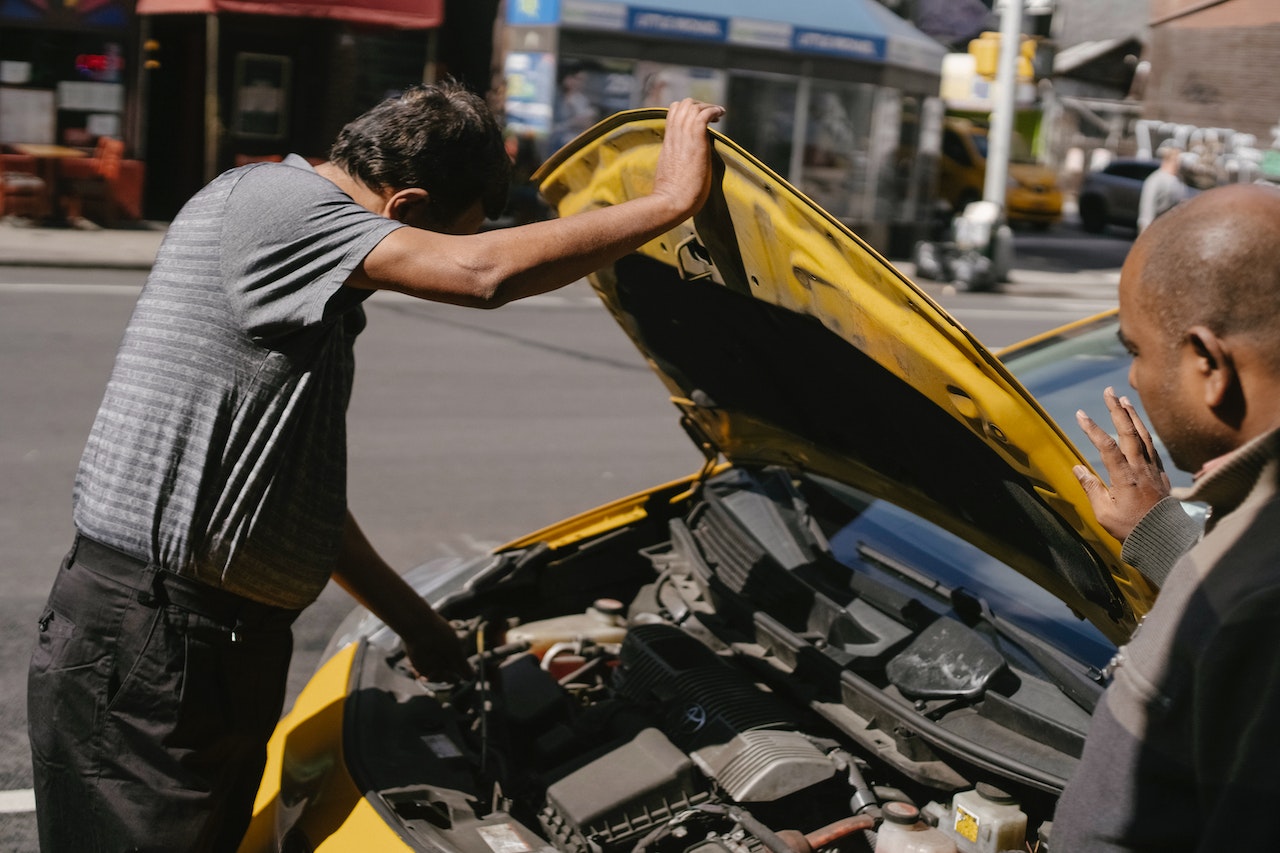Continue to drive with a defective radiator fan, and your car engine will start to overheat. That’s particularly the case in stop-and-go traffic or on a hot day in LA. I know from experience that the fan helps move air through the radiator when the car is stopped or moving slowly, keeping the engine cool.
Without a working fan, you should see the temperature gauge start to climb first. In this case, you might notice steam or detect a sweet smell from leaking coolant. In slow-moving L.A. Traffic, the chance of permanent engine damage increases quickly.
The longer the drive, the more heat and the more danger you’ll encounter. I’ll walk you through some early warning signs and what to look out for. In the paragraphs that follow, I detail the genuine perils at stake and lay out practical steps you can take to protect yourself.
Key Takeaways
- If I keep driving with a broken radiator fan, my engine can overheat quickly, especially in Los Angeles traffic or during hot weather.
- Overheating from a faulty fan can cause serious engine damage, like a blown head gasket or warped cylinder heads, which are expensive to repair.
- Even low-speed driving poses a risk when your radiator fan is broken, especially when taking short trips. It doesn’t take long for temps to climb, even on a brief trip.
- Regular checks of my fan, coolant levels, and the area around the radiator help me catch issues early and avoid breakdowns.
- I’m always listening for strange sounds and watching for that temperature gauge creeping up. With these moves, I’m able to identify fan issues before they worsen.
- As soon as I notice overheating, or suspect a fan failure, I stop driving immediately. Then, I’ll make an appointment with my mechanic to save my engine from costly damage.
Why Radiator Fans Break Down
Radiator fans play an important role in preventing engines from overheating. City traffic, stop and go conditions, or in very hot climates such as Los Angeles can put extra stress on these components. When these fans fail, it is not just a small inconvenience. Understanding why radiator fans break down allows you to identify the signs of impending failure sooner and ensure your vehicle continues to operate without issue.
Common Electrical Glitches
Most radiator fan issues begin on the electric side. A blown fuse is usually the first indicator. That usually indicates there’s a problem with the circuit. Faulty relays or worn fan motors will definitely leave you in the dust as well.
Inappropriate wiring is another concern. Bad wiring is a leading cause of fan failure. Wires can crack, fray, or corrode over time. Both wire wear and tear can be accelerated in a hot, stop-and-go city like LA.
Routine inspection for loose or corroded connections can prevent small problems from developing into larger failures.
Mechanical Wear and Tear
Fans are subject to harsh usage. Constant flexing can create blade cracking or fatigue and even wear out the fan clutch. This is especially true with older vehicles or after many miles on LA’s freeways.
If you notice odd noises or odd vibrations from the front end, take notice. These may be indications that the fan is beginning to fail. Continuing to drive with a damaged blade can quickly damage the radiator or other components located nearby.
Sensor Signal Problems
Radiator fans rely on accurate signals from temperature sensors to activate at the optimal time. If a sensor is defective, it can make the fan turn on too late or off too early.
When this occurs, the engine will overheat, particularly in stop-and-go driving conditions. Maintaining sensor functions makes a difference for fans. Keeping sensor readings on point is key to fan wellbeing.
Low Coolant Impact
Low coolant causes the opposite effect — less heat is pulled from the engine and the fan has to work even harder. Southern California heat, like what many of us are experiencing in June 2021, can exacerbate this problem.
Develop the routine practice of monitoring your coolant levels, as low coolant is directly linked to both overheating and poor fan operation.
Recognizing Fan Failure
Look out for dashboard warning lights, increasing temperature gauge readings, or unusual sounds. Recognizing fan failure is crucial. It only takes a small change in your routine to avoid a huge bill.
Defective fans are a major performance drag on the engine and can lead to a hot, expensive failure.
Signs Your Fan Isn’t Working
Signs of a failing radiator fanBefore serious trouble comes your way, the first thing you’ll likely see is your engine temperature gauge going up over the normal range. This is particularly true when you’re in stop-and-go traffic or stopped at a stoplight. In car-clogged, sweltering Los Angeles, this is a daily occurrence.
If you don’t stop driving with the fan out, excessive engine heat can accumulate quickly. That’s a tough load for your engine to bear and increases the chances of an engine failure.
Engine Temperature Spikes
You’ll start to notice strange noises originating from your engine bay. Unusual whirring or grinding sounds may be a sign that your fan is failing or has something obstructing it.
These noises may indicate damaged bearings, foreign objects trapped in blades, or even loose hardware. If you notice any strange sounds, it’s best to inspect the fan preemptively before further damage occurs.
Unusual Noises Under Hood
If the engine is running, the fan blades must be rotating. If you see them not moving, that’s bad news. This can be from a blown fuse, a busted relay, or sometimes even a bad motor.
Electrical problems or a blown fuse account for approximately 70% of fan failures. A simple, quick visual inspection should easily identify any broken, bent, or chipped blades. These problems prevent effective cooling and can cause the vehicle to quickly overheat, particularly on hot LA afternoons.
Fan Blades Not Spinning
An improperly working fan can drastically reduce your AC’s cooling potential. If you notice that the air coming from your car’s vents is getting warmer, watch out.
The AC may stop blowing cool air when you’re sitting in traffic, and it’s possible that the fan is the cause. Actions to ensure proper fan action will help keep your engine and cabin cool.
AC Performance Drops
Not only is driving with a broken fan dangerous, but repeated overheating can easily warp engine components, leading to thousands of dollars in repair bills.
Spot these issues early and repair them immediately to save your engine—and your bank account.
What Happens If You Keep Driving?
What can happen if you continue driving with a faulty radiator fan? If your engine is damaged, it can be very serious. Anyone who’s spent time in Los Angeles understands the traffic and heat that can cause even the most reliable car to give up.
Without a functioning fan, your engine won’t be able to cool down when you idle at red lights or slog through traffic during rush hour. In addition to creating a mess on your engine, the engine will begin to overheat quickly, particularly during hotter months.
In extreme cases, you may even notice steam billowing from under the hood, or an indicator light on your dashboard illuminating. When this occurs, the need to stop becomes immediate, as every additional mile could be doing more harm.
Immediate Engine Overheating Risk
Engine Overheating is one of the most common causes of blown head gaskets. On a typical car, repairing a blown head gasket costs more than $3,000. The only real way to prevent this is to avoid overheating your engine altogether.
Severe Head Gasket Damage
If the temperature continues to increase, the cylinder head will begin to warp. A warped head damages engine performance and may require an extensive engine rebuild. Taking swift action minimizes damage and your repair costs.
Warped Cylinder Heads Danger
The heat doesn’t end with the engine. It can cause your transmission fluid to become watery, which will destroy your transmission. Letting things cool down increases the life expectancy of all components.
Transmission Fluid Breakdown
Overheating engines often lead to hoses cracking, radiators busted, and leaking coolant nearly everywhere. The fan’s primary task is to keep these components cool, so ignoring failures puts the entire system in jeopardy.
Coolant System Component Failure
Overheating your engine can do a number of things, not the least of which is leaving you stranded on the side of the road. This danger increases in high-crash areas or during the midday heat.
Getting Stranded Unexpectedly
The more you drive with a faulty fan, the higher the repair costs climb. It’s a common adage in the field, but catching problems early is never more expensive.
Increased Repair Costs Later
Stop and go conditions in LA created by heavy traffic. Without a fan, that’s just a recipe for overheating.
Traffic Makes Overheating Worse
The hot summer weather only exacerbates all of these issues. A Southern California summer takes a toll on any car, so it’s worth it to stay ahead of cooling system maintenance.
Hot Weather Amplifies Issues
Even brief jaunts with a malfunctioning fan can overheat the engine well beyond danger zones. Since every drive has some chance of resulting in injury, these go unnoticed and uncounted.
Can You Drive Short Distances?
Short distance trips with a malfunctioning radiator cooling fan may seem like an acceptable short-term risk, but the potential danger is substantial. In LA, that stop-and-go traffic and hot air can majorly cook your car’s engine. We think you’ll be amazed at just how quickly it all comes together!
Without a reliable, functioning fan, the ability to cool disappears quickly. A couple minutes of idling or city driving can raise the temperature above acceptable limits within minutes. So even if you’re tempted to run that one short drive, especially in this heat, that risk of overheating lingers with every mile.
Understanding the High Risk
It may seem innocent to just drive a few blocks or hop in the car for that short errand. You can reduce risk by avoiding high speeds and cruising on crisp autumn mornings. These fixes are merely stopgaps from a political perspective.
In fact, one of the best mitigations for this is driving airflow. It only kicks in when you’re traveling faster than 10 or 20 miles per hour. When you’re sitting there in traffic or waiting at a red light, the engine continues to heat up.
In addition, the cooling fan is rendered completely ineffective. Even a Band-aid measure, such as topping off coolant, won’t save you from the real danger. Heat related illness can develop suddenly and fortune is not a strategy.
When It Might Seem Okay (But Isn’t)
When a short trip may seem okay (but isn’t) A broken fan blade or failed clutch can quickly cause catastrophic damage. The engine can only run for a few minutes before you start warping engine components or blowing gaskets.
Every trip adds to the damage, even if the vehicle holds up initially. For safe, reliable driving, patching the problem up isn’t enough—you need to repair it for real.
Why We Strongly Advise Against It
Make sure to test your fan and cooling system regularly. Pay attention to unusual sounds, moisture, or other indications of deterioration. Don’t wait for a breakdown—regular checks and early fixes save money and stress.
Avoiding preventable problems protects your vehicle and ensures it’s always safe and prepared for LA’s busy streets.

Quick Checks You Can Perform
If your radiator fan stops working, your engine will begin to overheat in a matter of minutes. This is particularly true in stop-and-go LA traffic or during extreme heat conditions. These early checks allow you to identify issues before they develop into more costly repairs.
Check for external indicators such as cracked blades, loose mounts, or melted plastic. Debris such as leaves or small pieces of garbage may clog the debris screen and/or fan belt, slowing down or blocking the fan.
Visually Inspect the Fan
Begin with an initial inspection of the fan through the grill or under the hood. Check for debris caught in the fan or any signs of damage such as fan blades that are chipped or bent.
Pay attention when you first start your car or when it warms up after idling for a few minutes. The fan should turn on when your engine temperature starts to increase. If you notice really loud clicking, buzzing, or grinding sounds, you may be hearing a damaged bearing or loose blade.
None at all when the temp goes up? That signals it’s time for your fan to turn on. You don’t have a lot of time to play around—overheating can occur in as little as a few minutes.
Listen for Fan Activation
If you determine through testing that the fan is supposed to spin but it’s still not turning on, inspect the fan motor itself. Connect two jumper wires from the battery (positive and negative) directly to the harness.
If the fan moves, then the fan motor is in good condition. If so, then there’s something wrong inside. A second, more advanced way to test is with a multimeter. If you have 12V on one side and 0V on the other side, you could have a blown fuse.
Check Fuses and Relays
Replace the fuses and relays associated with the fan circuit. These are some very inexpensive, simple repairs. If it is blown, replace it and test again.
Even if your cooling fan is operating perfectly at the moment, preventative checks ensure you don’t find yourself stranded on the 405. High temperatures or hilly terrain can seriously stress your system, so don’t overlook this step.
Preventing Fan Failure Proactively
Preventive maintenance for your radiator fan begins with the basics. A good first step to stay ahead of trouble is regularly checking your coolant and maintaining a tidy engine bay. In a place like Los Angeles, where extreme heat and urban stop-and-go traffic can really test your cooling system, all these steps are crucial.
Maintain Proper Coolant Levels
First, I ensure proper coolant level and frequently top off. When coolant stays below the proper line, the system has to overcompensate, and that puts a lot of strain on the fan causing it to fail prematurely. I use the specific coolant that’s made for my car—water or other generic ones can really screw up the system.
If the coolant looks old or dirty, I flush the system before corrosion—one of the main killers of fans—can set in. Replacing it with a high-quality thermostat, ideally an 80°C model, will help keep the engine at the right temperature. This change reduces the fan’s workload.
My practice is to add a water wetter for temperature control. That’s doubly appreciated when I’m idling in notorious LA traffic.
Keep Radiator Area Clean
I remove leaves, road grime and any debris building up on the radiator and fan blades. Dirt prevents airflow causing the fan to run on high all the time. When airflow is turbulent, the engine doesn’t cool as efficiently and the fan motor is subject to greater wear.
Don’t take the gamble. Driving with a broken fan blade can result in exacerbating damage and a more expensive repair bill.
Schedule Regular Cooling System Checks
Just like I wouldn’t skip getting my car checked periodically, I schedule regular cooling system checks. They are able to identify developing issues before they become costly repairs.
Mechanics use tools like a multimeter to check if the fan gets the right voltage—about 20% of fan failures come from electric trouble like fuses or wiring. By replacing the fan clutch every 50,000–100,000 miles, I maintain fan-dependent cooling, which allows me to run a consistent operation.
When to Call a Mechanic
If your car begins to overheat, take warning. If you start hearing odd sounds coming from under the hood, call a mechanic as soon as possible. In Los Angeles, stop-and-go traffic and extreme heat conditions tax engines.
An overheating radiator fan can go from a small nuisance to a big problem fast. When your temperature gauge is on the rise, don’t ignore it. If you notice steam or burning odors from the engine, contact a mechanic immediately to inspect it.
If you’ve tested everything and still can’t track down the problem, fear not. A skilled mechanic with the right tools can uncover and correct hidden issues.
Persistent Overheating Issues
If you experience persistent overheating, act quickly. An inoperative fan may cause your engine to overheat. This is particularly deadly in urban stop-and-go traffic or in the sweltering summer heat.
This may lead to warped engine components, or worse, a blown head gasket. Inspect your fan blades for any cracks or breaks. If you notice rattling sounds, it’s time to call a mechanic.
Addressing it sooner than later can help you avoid a $4,000+ repair bill later on.
If You Suspect Fan Failure
If you think your fan has failed, act fast. Look for loud whirring sounds or determine if there is no sound at all when the car is warming up. Don’t wait, as that can result in more serious engine damage, which usually requires expensive repairs.
By doing these simple checks and calling a mechanic when you don’t know, you’ll help your car stay on the road longer and save money in the process. Preventive maintenance, such as periodic inspections, has been shown to avoid the majority of car problems – including failures of your radiator fan.
Avoiding Further Engine Damage
A functional fan prevents costly engine damage. When in doubt, or when you don’t have the proper tools for do-it-yourself repairs, err on the side of caution. Never assume a mechanic will do the right thing.
Conclusion
If you’re driving through L.A.’s heat with a broken radiator fan, you’re asking for big problems in no time. I have witnessed the resultant cars blown up at stop-lights and people stranded on the side of the 405. When your radiator fan is broken, you’re making your engine work hotter and harder. This can cause warped components and a costly repair tab. While minor commutes in temperate conditions may squeak by, rush hour and hot July afternoons will increase exposure. Even if you’re riding with a fan, be sure to regularly monitor your temperature gauge and avoid getting trapped. If you notice something is wrong with your fan, have it diagnosed and repaired as soon as possible. Looking to avoid the frustration and expense? Keep an eye on any signs that your cooling system is not up to par and address minor repairs before they develop into major ones.
Frequently Asked Questions
1. Can I drive my car with a broken radiator fan in Los Angeles traffic?
If you have a broken radiator fan in LA’s stop-and-go traffic, you would be risking your engine overheating within just a few minutes. If the engine overheats it can cause severe damage and expensive repairs.
2. How do I know if my radiator fan isn’t working?
Pay attention to strange sounds. Test if your radiator fan is functioning by observing its operation as the vehicle begins to overheat, and look out for increasing engine temperature or warning lights on your dash.
3. What damage can happen if I ignore a broken radiator fan?
What damage can happen if I ignore a broken radiator fan? An overheating engine can lead to a warped cylinder head and blown head gasket, which can destroy your entire engine. Replacements and repairs can become costly very quickly.
4. Is it okay to drive short distances with a broken radiator fan?
If the weather is quite cool and you’re planning on just a brief drive, like less than 10 miles, you may be able to get away with it. Even then, it’s a dangerous gamble—overheating can occur quickly.
5. What quick checks can I do myself?
Monitor to see if the fan spins up when the engine reaches optimal temperature, check for blown fuses, and examine wiring. When in doubt, consult with a certified mechanic.
6. Can hot weather in Southern California make things worse?
The answer is yes, very much so. Can hot Southern California weather make overheating worse? Can hot weather in Southern California make the situation worse?
7. When should I call a mechanic?
When should I call a mechanic? Waiting will only worsen the issue and result in more costly repairs.
Are You Looking for Expertise with a Broken Radiator Fan?
Experience the excellence of autoTECH Blackhawk when it comes to resolving a broken radiator fan. Why trust us with your cooling‑system repair? Our standout feature is an unwavering dedication to building strong relationships with our clients—an essential element when your vehicle’s temperature regulation is at stake. This commitment forms the cornerstone of our tailored approach, ensuring every solution aligns with your specific goals for performance, efficiency, and long‑term engine health.
Whether you’re battling overheating, hearing odd fan noises, noticing the A/C struggling at idle, or simply seeking expert guidance on keeping your cooling system in peak condition, autoTECH Blackhawk is here to exceed your expectations. We proudly back every repair with an industry‑leading 3‑year / 36,000‑mile warranty and use only high‑quality, manufacturer‑recommended fans, relays, and sensors.
Don’t wait until a faulty fan leaves you stranded—contact our friendly team today to schedule a convenient, contactless consultation for your radiator‑fan repair needs!


